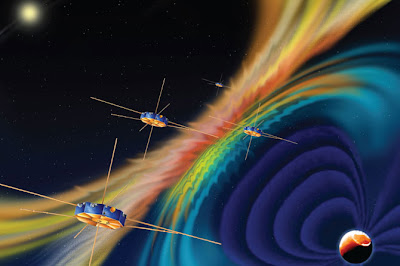
The northern hemisphere of Saturn's moon Titan is set for mainly fine spring weather, with polar skies clearing since the equinox in August last year. The visual and infrared mapping spectrometer (VIMS) aboard NASA's Cassini spacecraft has been monitoring clouds on Titan regularly since the spacecraft entered orbit around Saturn in 2004. Now, a group led by Sébastien Rodriguez, a Cassini VIMS team collaborator based at Université Paris Diderot, France, has analyzed more than 2,000 VIMS images to create the first long-term study of Titan's weather using observational data that also includes the equinox. Equinox, when the sun shone directly over the equator, occurred in August 2009.
Rodriguez is presenting the results and new images at the European Planetary Science Congress in Rome on Sept. 22.
Though Titan's surface is far colder and lacks liquid water, this moon is a kind of "sister world" to Earth because it has a surface covered with organic material and an atmosphere whose chemical composition harkens back to an early Earth. Titan has a hydrological cycle similar to Earth's, though Titan's cycle depends on methane and ethane rather than water.
A season on Titan lasts about seven Earth years. Rodriguez and colleagues observed significant atmospheric changes between July 2004 (early summer in Titan's southern hemisphere) and April 2010 (the very start of northern spring). The images showed that cloud activity has recently decreased near both of Titan's poles. These regions had been heavily overcast during the late southern summer until 2008, a few months before the equinox.
Over the past six years, the scientists found that clouds clustered in three distinct latitude regions of Titan: large clouds at the north pole, patchy clouds at the south pole and a narrow belt around 40 degrees south. "However, we are now seeing evidence of a seasonal circulation turnover on Titan – the clouds at the south pole completely disappeared just before the equinox and the clouds in the north are thinning out," Rodriguez said. "This agrees with predictions from models and we are expecting to see cloud activity reverse from one hemisphere to another in the coming decade as southern winter approaches."
Rodriguez is presenting the results and new images at the European Planetary Science Congress in Rome on Sept. 22.
Though Titan's surface is far colder and lacks liquid water, this moon is a kind of "sister world" to Earth because it has a surface covered with organic material and an atmosphere whose chemical composition harkens back to an early Earth. Titan has a hydrological cycle similar to Earth's, though Titan's cycle depends on methane and ethane rather than water.
A season on Titan lasts about seven Earth years. Rodriguez and colleagues observed significant atmospheric changes between July 2004 (early summer in Titan's southern hemisphere) and April 2010 (the very start of northern spring). The images showed that cloud activity has recently decreased near both of Titan's poles. These regions had been heavily overcast during the late southern summer until 2008, a few months before the equinox.
Over the past six years, the scientists found that clouds clustered in three distinct latitude regions of Titan: large clouds at the north pole, patchy clouds at the south pole and a narrow belt around 40 degrees south. "However, we are now seeing evidence of a seasonal circulation turnover on Titan – the clouds at the south pole completely disappeared just before the equinox and the clouds in the north are thinning out," Rodriguez said. "This agrees with predictions from models and we are expecting to see cloud activity reverse from one hemisphere to another in the coming decade as southern winter approaches."
